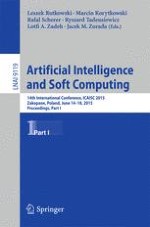The two-volume set LNAI 9119 and LNAI 9120 constitutes the refereed proceedings of the 14th International Conference on Artificial Intelligence and Soft Computing, ICAISC 2015, held in Zakopane, Poland in June 2015. The 142 revised full papers presented in the volumes, were carefully reviewed and selected from 322 submissions. These proceedings present both traditional artificial intelligence methods and soft computing techniques. The goal is to bring together scientists representing both areas of research. The first volume covers topics as follows neural networks and their applications, fuzzy systems and their applications, evolutionary algorithms and their applications, classification and estimation, computer vision, image and speech analysis and the workshop: large-scale visual recognition and machine learning. The second volume has the focus on the following subjects: data mining, bioinformatics, biometrics and medical applications, concurrent and parallel processing, agent systems, robotics and control, artificial intelligence in modeling and simulation and various problems of artificial intelligence.
